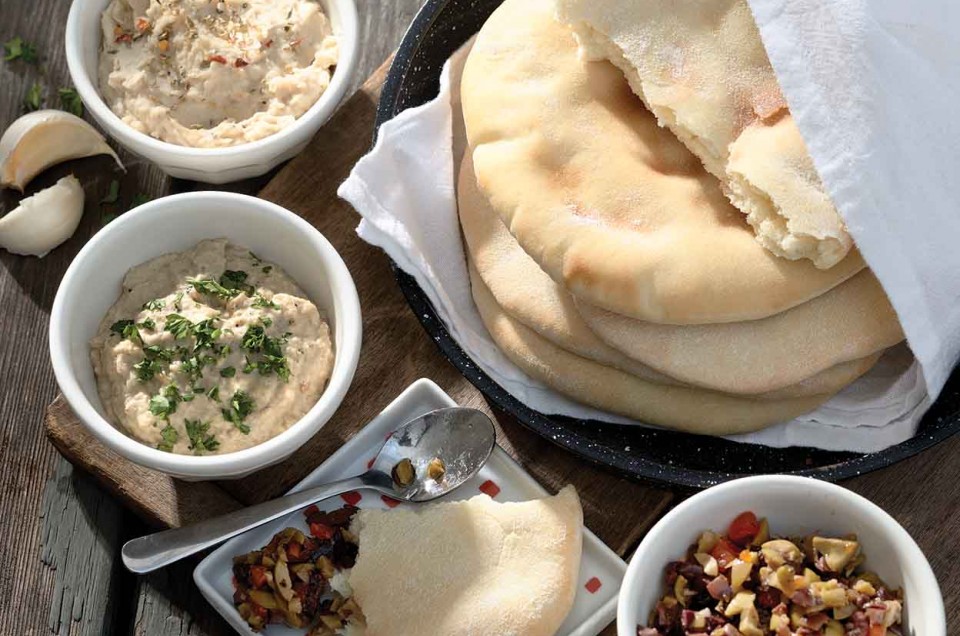


Have you ever made pita bread? It’s a great example of the Endless Quest for Success that baking can sometimes be.
Most of the things I bake are pretty reliable. If they're not, I stop fussing and move on. But there are two things I bake that are a roll of the dice every single time: Popovers, and pita.
If you’ve ever played golf, popovers and pita are just like the perfect drive. Eyes on the ball, slow backswing, weight shift… and there it goes, the ball making a perfect 250-yard parabola down the middle of the fairway. “Ah, yes,” I think to myself. “NOW I’ve got it.”
And I step up at the next hole, do the VERY SAME THINGS I did not 15 minutes before, and shank one about 30 yards into the water.
I’ve tried every popover method possible. Making batter in a blender (vs. mixer); letting it rest (vs. not). Into a cold oven; into a hot oven. Peeking; not peeking. Aluminum pan, cast iron, silicone. Sometimes they pop; sometimes they just lie there like a puddle of cream-colored mud. And I swear they’re laughing at me. “HA—and you call yourself a baker…”
Pitas do the same thing. When I lived in Maine and baked in a big old cast-iron Garland gas oven, my pitas really popped. They looked like little balloons in the oven, barely able to contain all of that steamy air in their thinly stretched skins.
But here, using an electric oven, my pitas lie quietly on their pan, rising just a half an inch or so. Just so I know that yeah, the yeast is working. But something else isn’t. Oh sure, the occasional pita will pop pretty nicely. But it’s so random… With three pitas on a pan, one pops, two don’t. I mean, what’s up with that? I can’t figure it out.
But I keep trying. And in the meantime, even when my pita doesn’t pop, it’s pretty darned good. I like to fold it around homemade tarragon chicken salad (with golden raisins and toasted almonds). And cut it into wedges for hummus.
And I comfort myself with the fact that, like the perfect golf shot, a popped pita is always a possibility, appearing in the oven just often enough to tease me into continuing my quest.
Like most yeast breads, pita dough isn't complicated to put together. Simply put all of the ingredients in a bowl...
Mix to form a cohesive dough...
And knead till smooth, and just a bit sticky/soft.
Put the dough in a lightly greased container, cover it...
...and let it rise for about an hour. It won't necessarily double in bulk. Though mine did, as you can see.
Gently deflate the dough, and shape it into 8 balls. They don't need to be smooth, but they should be round.
Working with 2 to 4 balls at a time, flatten each into a disk.
Then roll into a 6” circle. Keep the other dough balls covered as you work, so they don't dry out. Place the 6” circles on a parchment-lined baking sheet. If you have a baking stone, you can pick the parchment up and slide it right onto the stone, pitas and all. If you're not using a stone, you'll just leave parchment and pitas on the baking sheet.
Now, the secret is a REALLY hot oven. Like, 500°F. I have trouble bringing our test kitchen ovens to that temperature, so my pitas often don't pop. If I'm lucky, they kind of pop halfway, like this.
Most of the time they just kind of lie there and become golden, like this. Which is fine; they make a lovely, soft, wrap-type bread, perfect for wrapping around sandwich fillings, mopping up spaghetti sauce (I know, I'm mixing cultures here), or cutting into wedges and using as bread dippers.
In order to keep the pitas soft, stack them in a cotton towel as soon as they come out of the oven, and let them cool there.
Even when they don't pop, pitas are a nice-looking, comfort-type bread: soft, golden, tasty. That's why I'll never give up my quest for perfectly popped pita: it's so easy to love the failures!
Read, review, and rate (please!) our recipe for Golden Pita Bread.
Update: See comment from Cathie (Sept. 12, 2008) below. Her method of baking directly on the oven rack worked just fine for me, except I baked the pitas 5 minutes, because they didn't fully pop until 3 minutes. I used my favorite pizza crust recipe, as it's so easy to roll out. Here's a picture of the finished pitas; they've deflated a bit, but are still popped—yeah!

